Steve Bull's Blog, page 1254
November 17, 2017
How Elites Control the Way You Think About Economics

How Elites Control the Way You Think About Economics
Since the beginning of our nation, American elites have used their power to justify their disproportionate levels of wealth. Today, those few, those happy few, continue this wicked tradition with disturbing effectiveness. They do so by deploying an assortment of tried-and-true strategies to manipulate public sentiment in order to stay on top of the heap.
These strategies, however, are hardly novel. In fact, the game plan for today’s elite class is largely derivative of tactics used by some gilded individuals and corporate titans right after the New Deal. Kim Phillips-Fein, a historian and author of Invisible Hands: The Businessman’s Crusade Against the New Deal, has spent a lot of time researching just how these economic elites perpetuated self-serving (and arbitrary) economic arrangements.
She told me on our new podcast episode (which you can subscribe to here):
Starting in the 1930s and the 1940s, some American business people were highly troubled by the direction the country was taking—the rise of the New Deal, the rise of the labor movement, by what they thought was a widespread acceptance of Keynesian ideas. [They were concerned by] the idea that high wages mattered more than high profits for driving economic growth and development.
To resist the “creeping socialism,” Phillips-Fein revealed how the rich set up think tanks to pump out anti-labor propaganda, sponsored economists like Milton Friedman and Friedrich Hayek to consort with prominent businessmen, and indoctrinated politicians like Ronald Reagan to roll back economic progress for the many.
These tactics were instrumental in sending the predominant economic narrative back to a “business-friendly” state.
…click on the above link to read the rest of the article…
The Last Time These 3 Ominous Signals Appeared Simultaneously Was Just Before The Last Financial Crisis
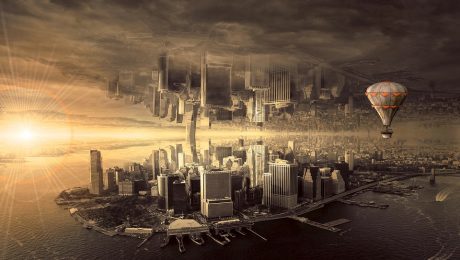 We have not seen a “leadership reversal”, a “Hindenburg Omen” and a “Titanic Syndrome signal” all appear simultaneously since just before the last financial crisis. Does this mean that a stock market crash is imminent? Not necessarily, but as I have been writing about quite a bit recently, the markets are certainly primed for one. On Wednesday, the Dow fell another 138 points, and that represented the largest single day decline that we have seen since September. Much more importantly, the downward trend that has been developing over the past week appears to be accelerating. Just take a look at this chart. Could we be right on the precipice of a major move to the downside?
We have not seen a “leadership reversal”, a “Hindenburg Omen” and a “Titanic Syndrome signal” all appear simultaneously since just before the last financial crisis. Does this mean that a stock market crash is imminent? Not necessarily, but as I have been writing about quite a bit recently, the markets are certainly primed for one. On Wednesday, the Dow fell another 138 points, and that represented the largest single day decline that we have seen since September. Much more importantly, the downward trend that has been developing over the past week appears to be accelerating. Just take a look at this chart. Could we be right on the precipice of a major move to the downside?
John Hussman certainly seems to think so. He is the one that pointed out that we have not seen this sort of a threefold sell signal since just before the last financial crisis. The following comes from Business Insider…
On Tuesday, the number of New York Stock Exchange companies setting new 52-week lows climbed above the number hitting new highs, representing a “leadership reversal” that Hussman says highlights the deterioration of market internals. Stocks also received confirmation of two bearish market-breadth readings known as the Hindenburg Omen and the Titanic Syndrome.
Hussman says these three readings haven’t occurred simultaneously since 2007, when the financial crisis was getting underway. It happened before that in 1999, right before the dot-com crash. That’s not very welcome company.
In fact, every time we have seen these three signals appear all at once there has been a market crash.
Will things be different this time?
We shall see.
If you are not familiar with a “Hindenburg Omen” or “the Titanic Syndrome”, here are a couple of pretty good concise definitions…
…click on the above link to read the rest of the article…
Madagascar Outbreak: It Is ‘Inevitable’ The Plague Becomes Resistant To Drugs

The newest warning about the outbreak of the airborne pneumonic plague, or black death, in Madagascar has been released. Officials warn that it’s inevitable that this bacterial infection that’s infected over 2000 people will become resistant to antibiotics.
The only way to treat a person who has contracted the plague is with antibiotics. But experts now warn that because they are being used so much to treat the infection, antibiotics resistance is inevitable and making this disease much more terrifying. Once the bacteria is resistant, the Madagascar healthcare system will be overwhelmed, and the disease will have control of the nation.
According to the Daily Mail, Madagascar’s healthcare system will be unable to cope if the deadly plague outbreak continues to escalate, a scientist has warned. Scores of doctors and nurses have been struck down with the disease, which is predicted to gather momentum in the coming weeks and there are growing fears hospitals will be unable to meet the illness’ burden. Official figures reveal at least 2,034 people have been infected with the “medieval disease” so far in what has been described as the “worst outbreak in 50 years.” The black death outbreak has so far claimed at least 165 lives.
Although the plague is responding well to antibiotics right now, drug resistance is also an increasing concern amongst experts who predict it will vastly accelerate the disease’s death toll. Professor John Joe McFadden from the University of Surrey told MailOnline: “Fortunately in [the] plague, it has not developed much antibiotic resistance. If that kicks in, the plague will be far, far scarier. If you throw more and more antibiotics at patients, antibiotic resistance is more or less inevitable.”
…click on the above link to read the rest of the article…
The Pandora’s Box of the Digital Age
In the past year alone, a series of hacks and ransomware attacks by hostile governments and other malign actors have raised alarms about a major threat to global stability. Unfortunately, many governments are responding by developing still more cyber weapons, on the mistaken assumption that offense is the best defense.
STOCKHOLM – Is the world sliding dangerously toward cyber Armageddon? Let us hope not; but let us also apprehend the threat, and focus on what to do about it.
One country after another has begun exploring options for bolstering their offensive capabilities in cyberspace, and many other countries have already done so. This is a dangerous escalation. In fact, few other trends pose a bigger threat to global stability.
Almost all societies have become heavily dependent on the Internet, the world’s most important piece of infrastructure – and also the infrastructure upon which all other infrastructure relies. The so-called Internet of Things is a misnomer; soon enough, it will be the “Internet of Everything.” And our current era is not a Fourth Industrial Revolution; it is the beginning of the digital age, and the end of the industrial age altogether.
The digital age has introduced new vulnerabilities that hackers, cyber criminals, and other malign actors are already routinely exploiting. But even more alarming is the eagerness of national governments to conduct cyber-warfare operations against one other.
We have already reached the stage at which every conflict has a cyber dimension. The United States and Israel crossed the Rubicon in 2010 by launching the Stuxnet attack on Iran’s nuclear facilities. Now, there is no telling where ongoing but hidden cyber conflicts begin and end.
…click on the above link to read the rest of the article…
William Rees: What’s Driving The Planet’s Accelerating Species Collapse?
Spoiler alert: It’s us
The data regarding planetary species loss just gets more alarming.
Today’s podcast guest is bioecologist and ecological economist Dr. William Rees, professor emeritus of the University of British Columbia’s School of Community and Regional Planning. Rees is best known for his development of the “ecological footprint” concept as a way to measure the demand a particular population places on the environmental resources it needs to survive.
Since the beginning of modern agriculture (around 1800), human activity has increased demand on planetary resources at an exponential rate. More energy has been expended — and more resources consumed — in the past 40 years than in all of human existence beforehand. That is placing a greater and greater strain on ecosystems that are now dangerously depleted:
At the dawn of agriculture, just ten thousand years ago, human beings accounted for less than 1% of the total mammalian biomass on the planet. Today, there’s been a sevenfold increase, roughly speaking, in the biomass of vertebra species on the planet — but most of that is human-induced. Today, human beings account for about 32 – 35%of the total biomass of mammals, a much greater biomass than at the dawn of agriculture. But when we throw in our domesticated animals and our pets, humans and their domesticated animals amount to 98.5% of the total weight of mammals on planet Earth.
So we’re engaged here, through sheer growth, in the scale of the human enterprise in what ecologists refer to as “competitive displacement”. This is a finite planet. There’s a finite flow, a limited flow, of photosynthetic energy through the planet which we share with millions of other species. Now, on a finite planet with limited energy flow, the more any one species takes the less is available for everything else.
…click on the above link to read the rest of the article…
NATO: a Dangerous Paper Tiger

NATO: a Dangerous Paper Tiger
The Chinese have a genius for pithy expressions and few are more packed with meaning, while immediately understandable, than “paper tiger”. NATO is one, but paper tigers that overestimate their powers can be dangerous.
Some Russians are concerned that there are today more hostile troops at the Russian border than at any time since 1941. While this is true, it is not, at the moment, very significant. The Germans invaded the USSR with nearly 150 divisions in 1941. Which, as it turned out, were not enough.
Today NATO has – or claims to have – a battle group in each of the three Baltic countries and one in Poland: pompously titled Enhanced Forward Presence. The USA has a brigade and talks of another. A certain amount of heavy weaponry has been moved to Europe. These constitute the bulk of the land forces at the border. They amount to, at the most optimistic assessment, assuming everything is there and ready to go, one division. Or, actually, one division equivalent (a very different thing) from 16 (!) countries with different languages, military practices and equipment sets and their soldiers ever rotating through. And, in a war, the three in the Baltics would be bypassed and become either a new Dunkirk or a new Cannae. All for the purpose, we are solemnly told, of sending “a clear message that an attack on one Ally would be met by troops from across the Alliance“. But who’s the “message” for? Moscow already has a copy of the NATO treaty and knows what Article V says.
In addition to the EFP are the national forces. But they are in a low state: “depleted armies” they’ve been called: under equipped and under manned; seldom exercised. The German parliamentary ombudsman charged with overseeing the Bundeswehr says “There are too many things missing“. In 2008 the French Army was described as “falling apart“. The British Army “can’t find enough soldiers“.
…click on the above link to read the rest of the article…
Implementing the Helm Review on the Cost of UK Energy
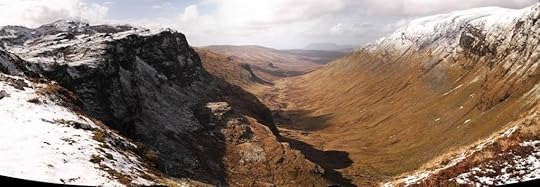 The UK Government has made a call for evidence on the Helm Review published on 25th October 2017. At the time the review was published I chose not to share my opinions on the consequences of implementing Helm’s proposals since I believe these may be far reaching and have a large negative impact on UK citizens, businesses and the economy. At the time I did not want to upset the apple cart since I also believe Helm offers the best path forward for so long as the UK Government remains committed to its 2008 Climate Change Act (CCA). Helm’s proposals will deliver sharply higher energy and electricity prices, carbon reduction and hopefully a functioning energy and electricity system and market. Muddling along as now will also deliver sharply higher prices with no guarantee of carbon reduction and the near certainty of a broken and dysfunctional energy system.
The UK Government has made a call for evidence on the Helm Review published on 25th October 2017. At the time the review was published I chose not to share my opinions on the consequences of implementing Helm’s proposals since I believe these may be far reaching and have a large negative impact on UK citizens, businesses and the economy. At the time I did not want to upset the apple cart since I also believe Helm offers the best path forward for so long as the UK Government remains committed to its 2008 Climate Change Act (CCA). Helm’s proposals will deliver sharply higher energy and electricity prices, carbon reduction and hopefully a functioning energy and electricity system and market. Muddling along as now will also deliver sharply higher prices with no guarantee of carbon reduction and the near certainty of a broken and dysfunctional energy system.
[Inset image is the Coire Glas pumped storage hydro scheme in Scotland, designed to store surplus wind power and provide 30GWh of storage. Still empty after all those years, Coire Glas stands as testimony to renewable fantasy colliding with thermodynamic and economic reality.]
Energy is More than Electricity
Helm’s review was on the cost of UK energy, which encompasses oil, gas, coal, nuclear and renewables. While his review is focussed on electricity he does make sufficient reference to these other energy sources to make clear that his recommendations apply to the whole energy system.
[Inset image is the Coire Glas pumped storage hydro scheme in Scotland, designed to store surplus wind power and provide 30GWh of storage. Still empty after all those years, Coire Glas stands as testimony to renewable fantasy colliding with thermodynamic and economic reality.]
…click on the above link to read the rest of the article…
November 16, 2017
EU Preparing for the Banking Crisis
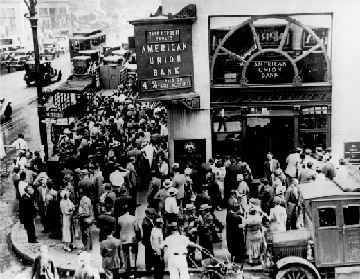 Subtly, the EU is looking to establish preparations for the coming banking crisis and how to protect the banks from massive withdrawals. The solution? The EU wants to be able to temporarily free up credits for the banks and at the same time to freeze bank deposits, In other words, like Greece, you just won’t be able to withdraw funds. Obviously, everything will be frozen. The current EU plan envisages blocking account disbursements for five working days and with the authority to extend any suspension to up to 20 days. They may need longer!
Subtly, the EU is looking to establish preparations for the coming banking crisis and how to protect the banks from massive withdrawals. The solution? The EU wants to be able to temporarily free up credits for the banks and at the same time to freeze bank deposits, In other words, like Greece, you just won’t be able to withdraw funds. Obviously, everything will be frozen. The current EU plan envisages blocking account disbursements for five working days and with the authority to extend any suspension to up to 20 days. They may need longer!
I recommend that you have 30 days worth of cash on hand. What the authorities do not understand is that if they freeze one bank, a run will unfold on all banks. The public will not believe whatever the government says. Therefore, banks that are not in crisis can be pushed into a crisis by a contagion. That is simply how it all unfolded in 1931-1933. The only way to stop a contagion will be a bank holiday and you have to close them all.
Why Core Inflation is Rising & What it Means for Fed Rate Hikes
Yellen was right to brush off “transitory” factors of “low” inflation.
Consumer prices, as measured by CPI for October, rose 2.0% year-over-year. A month ago, CPI increased 2.2%. The Fed’s inflation target is 2%, but it doesn’t use CPI, or even “Core CPI” – which excludes the volatile food and energy items. It uses “Core PCE,” which usually runs lower than CPI, and if there were an accepted measure that shows even less inflation, it would use that. But it does look at CPI, and there was nothing in today’s data to stop the Fed from raising its target rate in December.
The Core CPI rose 1.8%, up a tad from September’s 1.7% increase. Core CPI has been above 2% for all of 2016 and through March 2017. In the history of the data going back to the 1960s, Core CPI had never experienced “deflation.” But when Core CPI rates retreated in the spring through August, along with other inflation measures, a sort of panic broke out in the media:
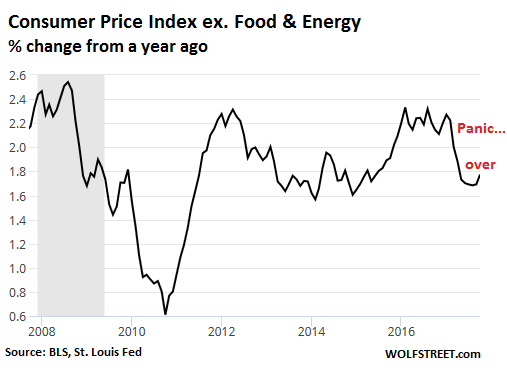
But the retreat was repeatedly brushed off as “transitory” by Fed Chair Janet Yellen and other Fed governors, starting in June, when they vowed to continue raising rates “gradually” and proceed with the QE unwind. Yellen had specifically pointed at a few of those “transitory” factors. These factors are now turning around. Core prices have re-accelerated their increases.
One of the “transitory” factors Yellen had pointed out specifically was telephone services, which includes the monthly costs that consumers pay for their smartphones and landlines. Those costs had plunged as a price war among wireless carriers broke out in 2016. This summer, the CPI for wireless services plunged as much as 13% year-over-year. Consumers loved it, but it couldn’t last.
…click on the above link to read the rest of the article…
Dakota Access Pipeline Company Paid Mercenaries to Build Conspiracy Lawsuit Against Environmentalists

Photo: Michael Nigro/Pacific Press/LightRocket/Getty Images
DAKOTA ACCESS PIPELINE COMPANY PAID MERCENARIES TO BUILD CONSPIRACY LAWSUIT AGAINST ENVIRONMENTALISTS
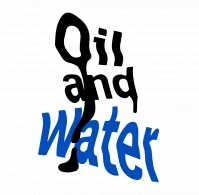 Oil and Water
Oil and WaterThe private security firm TigerSwan worked to build a RICO suit accusing Greenpeace, Earth First, and BankTrack of inciting protests to increase donations.
VIEW MORE FROM THIS TIMELINE STORY
THE PRIVATE SECURITY firm TigerSwan, hired by Energy Transfer Partners to protect the controversial Dakota Access pipeline, was paid to gather information for what would become a sprawling conspiracy lawsuit accusing environmentalist groups of inciting the anti-pipeline protests in an effort to increase donations, three former TigerSwan contractors told The Intercept.
For months, a conference room wall at TigerSwan’s Apex, North Carolina, headquarters was covered with a web-like map of funding nodes the firm believed it had uncovered — linking billionaire backers to nonprofit organizations to pipeline opponents protesting at Standing Rock. It was a “showpiece” for board members and ETP executives, according to a former TigerSwan contractor — part of a project that had little to do with the pipeline’s physical security.
In August, the law firm founded by Marc Kasowitz, Donald Trump’s personal attorney for more than a decade, filed a 187-page racketeering complaint against Greenpeace, Earth First, and the divestment group BankTrack in the U.S. District Court of North Dakota, seeking $300 million in damages on behalf of Energy Transfer Partners. The NoDAPL movement, the suit claims, was driven by “a network of putative not-for-profits and rogue eco-terrorist groups who employ patterns of criminal activity and campaigns of misinformation to target legitimate companies and industries with fabricated environmental claims.”
“It was as if the entire campaign came in a box. And of course it did,” the suit alleges. “Its objective was not to protect the environment or Native Americans but to produce as sensational and public a dispute as possible, and to use that publicity and emotion to drive fundraising.”
…click on the above link to read the rest of the article…




